Gateway ID49: Mixing the Bag
by Dustin Sklavos on September 23, 2010 2:46 AM ESTLow and Medium Gaming on the ID49C
The benchmarks we run in our gaming suite should provide some fairly interesting results, especially in placing the NVIDIA GeForce GT 330M's relative performance against the 325M and 335M. The 325M sports 48 "CUDA cores" and a 128-bit memory bus just like the 330M, but at lower clock speeds, while the 335M moves up on the food chain and uses a harvested GeForce GT 240 die, running at slightly lower clocks than the 330M but bumping up to 72 shader cores.
There's a caveat to these results, however: for StarCraft II we had to manually tweak the display drivers to get Optimus to work with it (before we did the game ran at a constant 4fps, which is slow even for Intel's HD Graphics.) Also, there seems to be a bug with Optimus in Left 4 Dead 2 using the latest 260.63 drivers, where setting the game to 4xAA results in a blank screen. Unfortunately, we couldn't get the ID49C to run L4D2 with 4xAA on the 258.96 drivers either, something which wasn't an issue on the ASUS N82Jv. Those test results—for our "High" preset—are mostly academic as the 330M really isn't powerful enough to be pushing anti-aliasing anyhow, but it bears mentioning nonetheless.
Of course, all of this is going to be rendered fairly meaningless soon enough: GeForce 400M series parts should start trickling in soon, and hopefully they'll bring the kind of performance improvements NVIDIA has desperately needed on the mobile front. Optimus is a great technology AMD just doesn't have a counter for right now, but AMD's mobile parts are generally faster in their given classes. Hopefully with the 400Ms NVIDIA will be able to give us everything: better performance, DX11 support, and better battery life thanks to Optimus.
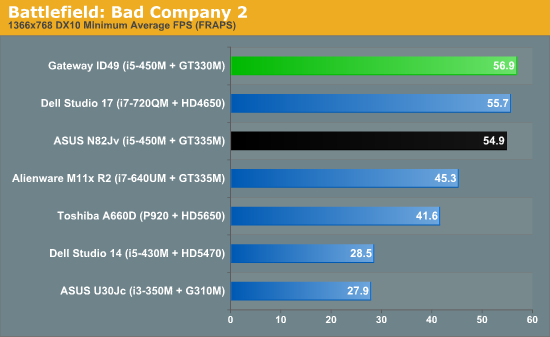
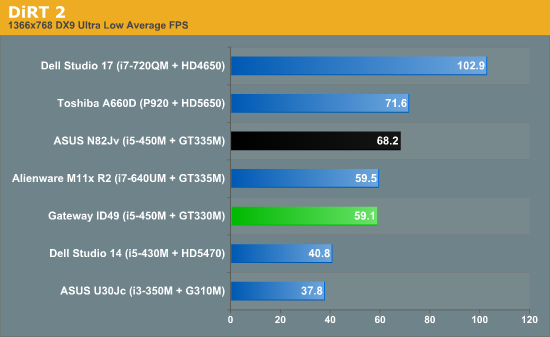

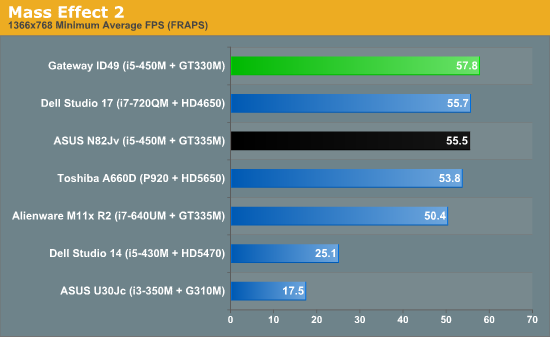

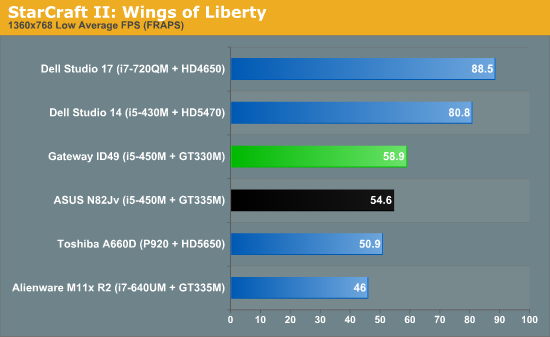
At these minimal settings, the GeForce GT 330M in the ID49C is able to post playable framerates on every game in our suite with room to spare. In most cases the testing units seem to be CPU limited, though the GeForce G 310M and Mobility Radeon HD 5470 are so anemic to begin with that even at minimal settings they threaten to bog down gaming performance. The exception is StarCraft II, where for whatever reason the Radeons seem to take it to the GeForces. The only Radeon not posting framerates over 80 is the HD 5650 in the Toshiba A660D, hamstrung by a slow Phenom II in a game traditionally CPU limited at even the highest settings. Also somewhat interesting is that the ID49C manages to best the GT 335M in the N82Jv in several games, despite sharing the same CPU. We'll see that once we up the quality settings, the GT 335M is able to take the lead.
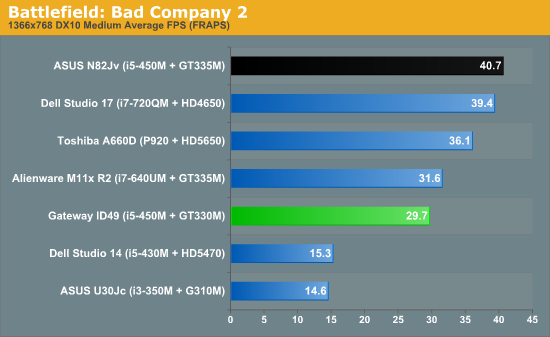
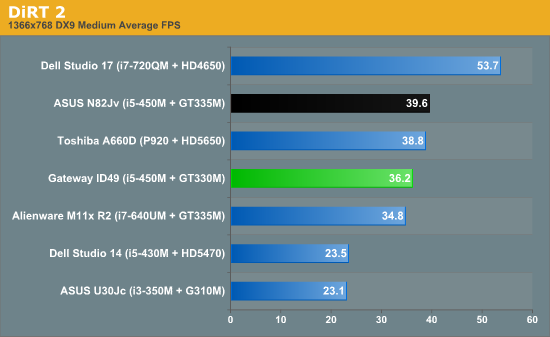
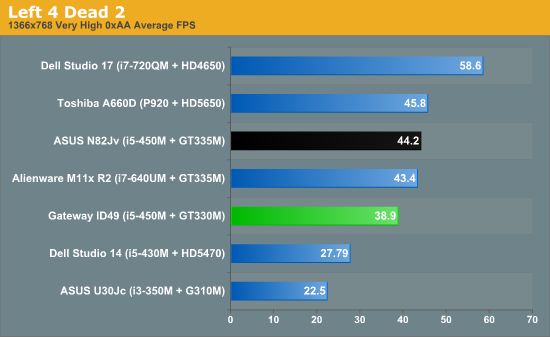
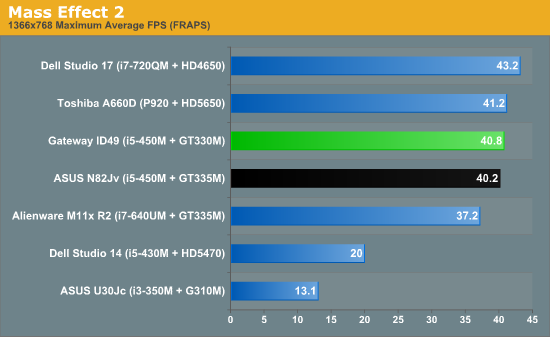
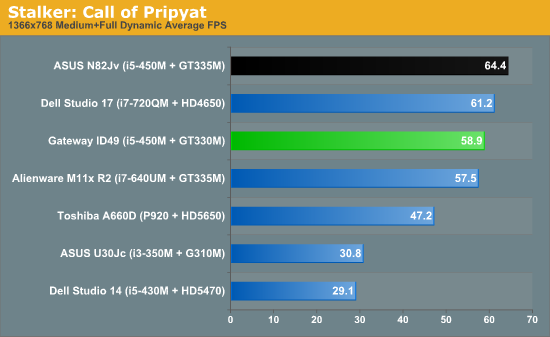
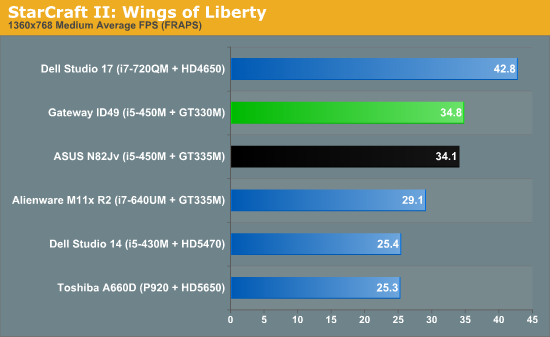
Once we start to ratchet up graphics settings, our testing suite starts to separate the men from the boys, and it's here that the GeForce GT 330M unfortunately exposes the weak link in Nvidia's current (and thankfully soon to be retired) mobile lineup. The GT 330M is extremely common, but it consistently loses to the Mobility Radeon HD 4650. The 4650 is an old chip; when it dropped it was an absolute powerhouse for the market segment, but it's been around for nearly two years, and Nvidia is only just now getting around to answering it with the 400M series. Even the GT 335M has problems with it.
Taken in a vacuum, the 330M is able to produce playable framerates in every game we tested it in, but it doesn't have much headroom. Its bigger brother, the 335M, and AMD's newer Radeon HD 5650 both come out looking pretty bad too. The 5650 proves itself as an incremental at best upgrade over the 4650, although it's important to keep in mind that the A660D is CPU-limiting it and worse, the 5650 itself is clocked 100MHz below spec in that unit. But the 335M, despite having a 100MHz slower clock speed has 72 shaders instead of the 330M's 48, and it still barely holds a lead, likely because both parts have the same memory bandwidth.










43 Comments
View All Comments
xype - Thursday, September 23, 2010 - link
"MBP's screen are decent, but no where near the best in term of "high-res" and "uniformity" and "view angel"."Erm, ever heared of "context"? We're talking consumer laptops here, not $4k tablets or whatever. Obviously you could get a better panel if you spent $20k on a laptop...
"just because you are in "lame-hipster-web-app-and-design business" doesn't mean you need a good screen."
Actually it does mean that, at least if you're dealing with the design side of things (which I do).
But, yeah, tablets are a different story—the iPad has an IPS screen, too. Doesn't mean anything in the context of consumer 13-17" laptops, though—which is what I am interested in.
seanleeforever - Thursday, September 23, 2010 - link
i did not take it out of context. review your own post and think before posting.most would agree that MBP is not a cheap consumer laptop. it is their pro line and cost 1.8k to 4.1k. so exactly how did i take it out of context? (i did not consider the 13 inch because their screen is just as average as any panel in Dell/HP, their 15/17 are the only ones using 6-bit TN with 3 color LED backlit, as an apple PRO owner that does web design, you should at least know that, right?)
out of the three examples i pointed out, the HP dreamcolor is NOT a tablet. it is on their elitebook and it is 10 bit IPS screen. it is on their 15 and 17 inch elitebooks, and that is exactly within the context of 13~17" laptop, which is what YOU interested in.
allow me to say this: LCD screen, even regular TN screens look pretty damn nice under ideal condition. but what separately pro/business from consumer is 1: price tag 2: performance under all conditions.
lastly, i did say Apple screens are noticeably better than average screen, but to say it is the BEST is simply a display of your ignorance. it is the same part used in other laptops and perform the same. i fail to see how screen is the reason for you to justify your choice.
JarredWalton - Thursday, September 23, 2010 - link
For the record, the 13.3" MBP has a good screen as well (just no matte option). The regular MacBook on the other hand has a crappy ~200:1 contrast ratio. We'll have something of a comparative review in the near future for some fun.... :-)xype - Friday, September 24, 2010 - link
"most would agree that MBP is not a cheap consumer laptop. it is their pro line and cost 1.8k to 4.1k"Yeah, except that the standard configurations (which is what most people buy) are 1.2 to 2.3K. If a "pro line" starts at 1.2 then that means that the people's expectations of laptops and computers in general got pretty weird lately. And I guess the 3k HP EliteBook is, what, space technology?
"lastly, i did say Apple screens are noticeably better than average screen, but to say it is the BEST is simply a display of your ignorance"
Can you point me to where I claimed they were the best?
" i fail to see how screen is the reason for you to justify your choice."
It's not the sole reason, but a very important one none the less. If you fail to see how it might be a reason to justify a laptop, feel free to get the Gateway and enjoy the shitty screen.
Ivan Karkour - Monday, September 27, 2010 - link
What happened to reading what the person comments? Seanleefore mentions laptops too, and he mentions a good selection. Talk about disregarding what the person says..Seanleefore, although quite biased, mentioned the Dell Studio XPS line, along with the M4500. They all have the resembling screen as the mac book pros have. It's true.
Look for yourself. You can grab the Studio XPS 16 for about 1,200 dollars, and recieve the Core i5 450, an ATI HD 5730, (which whoops the hell out of a MBP 13" graphics card), and all the rest of same specs with HD audio, and 2 year service---with the SAME screen.
The only downfall---not as light as the 13" MBP, and not as battery efficient. Oh, and of course the sturdiness of that mac book is pretty much kick ass. --but there. Seanleefore called you out, and he was correct. Sorry.
You speak of apple as if they are affordable. Maybe to you, but 1,300 dollar laptops, ( excluding tax), that rise all the way to 2,000 dollars isn't technically consumer friendly for the majority of people either. Although, you are right about 4,000 dollars being a bit steep. ha ha
Aircraft123 - Thursday, September 23, 2010 - link
The notebooks that come the closest to competing with the MBPs would have to be the HP ENVY series. I have the Envy 15 and it has the best LCD panel I have ever seen on a notebook. 1920x1080 AND an anti glare coating.They get much flak for running hot, however, the MBPs do too.
I also get a Mobility Radeon 5830 graphics card, a Core i5, 4GB RAM and a very well designed and built magnesium/aluminum chassis for much less than the MBP.
Don't get me wrong, Apple makes some very impressive hardware and the Envys are not without their faults.
If you are looking for a PC that has a chance of competing with Apple for less money, they are worth taking a look at.
kmmatney - Friday, September 24, 2010 - link
I had a look at the Envy 15. Seems nice, except that there is no internal optical drive, which is kind of odd for a 15" laptop.You can get a slot load DVD with the Dell Studio 15, along with a 1080P true-life display, 6 GB of RAM, back-lit keyboard for $1025, which is less than the ENVY, although the video card is not as good. So I'd recommend the Dell studio line also as a good overall laptop.
Roland00 - Friday, September 24, 2010 - link
while you can still order these products from the HP website, the HP envy 15 and 13 inch are winding down. Pretty much from suppliers that aren't HP you will only find clearance models or refurbished options.The HP envy 14 and 17 inch have replaced the 13 and 15 inch. The HP envy 14 and 17 inch have dvd/blu ray options.
The HP envy uses a metal case and has a much better video card.
Ivan Karkour - Monday, September 27, 2010 - link
Your definitely right about the Envy, but no slot loading drive :( Kinda lame for a 15", huh? Although I think there are the newer lines that came out. I believe they have slot loading.Hey, don't forget about the Dell Studio XPS 16. That's a kick ass piece of machinery. --and hey, a slot loading drive. ha ha
Although, it doesn't compare to the Envy with the 5830. The XPS has the 5730. You can get a higher grade one, but more money is needed of course.
Minion4Hire - Thursday, September 23, 2010 - link
Okay. I'm not going to come in here and sing Gateway's praises or pretend that this is a fantastic laptop, but I think your negativity is a little overzealous Dustin. I have used both the ID49 and ID59 series and did not view it nearly as negatively as yourself (certainly not so emphatically anyhow)This is a mainstream laptop. You yourself make note of this fact. This is a laptop being produced for the masses. MOST people want a computer that performs well (even if they don't quite know where said performance comes from or what they're paying for) but at the same time a lot of people want something stylish. Gateway is clearly trying to meet the consumer halfway; they're offering an above-entry-level product with a higher-end STYLE at a reasonable price. Their product page reeks of this: "Metal-like keys match the slender and stylish profile of the arctic silver cover and make typing an experience of ultimate smoothness. A cool-blue illuminated touchpad creates an inviting effect that draws your fingers". Sorry, but the average consumer will eat that up.
Speaking of the average consumer, most are not very picky about their keyboard, they haven't the slightest clue about screen quality, and do not use navigation keys of any kind. The AVERAGE consumer deletes highlighted text before typing, are confused and/or are barely aware of Fn keys, and wildly whirl their mouse cursor around the screen in an attempt to click "Google Search" instead of just pressing enter. So for these people dedicated volume keys are a good thing, and anorexic arrow keys which double as navigation aren't a detriment. The keyboard flex could and should definitely be improved, but at least it doesn't have a more annoying layout; small backspace key, the left Fn key on the outside of the Ctrl key, etc...
I'm not saying that the average consumer doesn't deserve a better product, but at the higher pricepoint required to offer those consumers that better product they will invariably end up looking at a different, cheaper model of laptop. I think it's hard to offer an "inbetween" laptop when the lower and higher ends of the market seem to be alienating each other more and more, so in some ways I think Gateway has hit their target audience beautifully; it's just not the Anandtech audience. If I want a well built laptop I'll buy Lenovo. If I want an inexpensive not-complete-piece-of-crap for my parents, or their parents, then I would look at mainstream offerings like this Gateway.